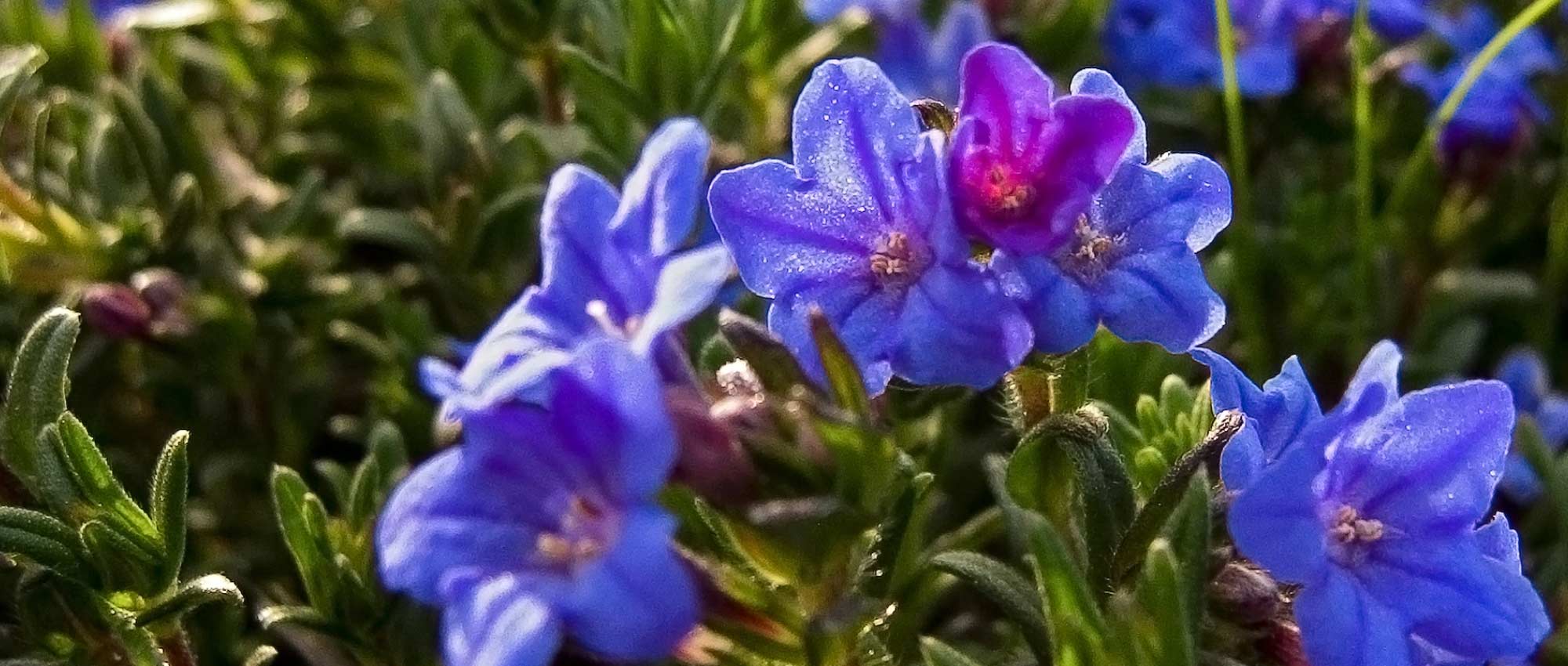
Lithodora: planting, growing and care
Contents
Lithodora in a nutshell
- Lithodora charms with its delicate, star-shaped blue flowers
- It is a shrub with a mat-forming habit that makes a good, fairly dense groundcover
- It is very floriferous and becomes covered with a multitude of flowers in spring
- Its evergreen foliage remains decorative even in winter
- Ideal in rock gardens, on low walls, banks… or at the front of borders
- It tolerates drought well, is hardy and not very prone to disease
A Word from Our Expert
Lithodora, or gromwell, is a shrub with a mat-forming, very spreading habit, making it a good groundcover. In spring it bears countless small star-shaped flowers, usually blue, sometimes white. It is very floriferous, offering abundant flowering. In addition, its foliage is evergreen, which makes it decorative all year round! Its leaves are small, elliptical and dark green, which nicely set off the paler flowering. There are a few particularly interesting varieties to grow in the garden. Among them, the Lithodora diffusa ‘Heavenly Blue’ has the advantage of producing very abundant flowering made up of a multitude of small blue flowers, while the variety Lithodora diffusa ‘Star’ bears numerous bicoloured blue-and-white flowers.
Lithodora is an excellent rock garden plant, but it is also suitable for container growing and can be planted on a low wall. Thus, it is possible to grow it even without a garden! It adapts well to small spaces. It forms a good, well-spreading groundcover and has the advantage of retaining its leaves in winter.
Lithodora thrives in full sun in free-draining soil. It is hardy and tolerates drought fairly well. Lithodora diffusa does not like calcareous soil but prefers rather acidic soil (which is not the case for other species!). It is easy to propagate by taking a cutting. It also has the advantage of requiring almost no maintenance!
Botany
Botanical data
- Latin name Lithodora diffusa, or Glandora diffusa
- Family Boraginaceae
- Common name lithodora, gromwell
- Flowering often in May–June
- Height up to 30 cm
- Sun exposure full sun
- Soil type well-drained, even stony, rather acidic
- Hardiness between −12 and −15 °C
Lithodora are bushes or shrubs, generally with a very spreading, prostrate habit and evergreen foliage. Lithodora diffusa (or gromwell) is most commonly cultivated. In wild state it is found in scrubby habitats and at woodland edges, sometimes in mountainous areas, from south‑west Europe to Turkey and North Africa. Generally, lithodora (and related genera) grow mainly in dry, arid, stony and rather warm places.
Lithodora belongs to family Boraginaceae (nearly 2,700 species). Notable members include borage (Borago), comfrey (Symphytum), lungworts, forget‑me‑nots, brunneras, Omphalodes, bugloss (Anchusa)… It is interesting that most of these plants bear small five‑petalled blue flowers, like lithodora. Most produce delicate, gentle flower displays. Boraginaceae are generally pubescent plants bearing flowers arranged in cymes, composed of five fused petals, five sepals and five stamens.
Lithodora diffusa was formerly known as Lithospermum diffusum; it has recently been renamed and should now be called Glandora diffusa. It is very close to genera Lithospermum and Buglossoides. Name derives from Greek lithos: stone, and dorea: gift, because it thrives among stones in rocky habitats. Specific epithet diffusa refers to its “diffuse”: very spreading habit. In French, lithodora is called Grémil.
Lithodora diffusa and cultivars derived from it (‘Star’, ‘Heavenly Blue’…) are the most grown. However, other very decorative species deserve attention: Lithodora oleifolia, Lithodora zahnii or Lithodora fruticosa, for example. Do not hesitate to try growing them!
Lithodora is a shrub with a compact, spreading habit, reaching up to 30 cm in height at most (often under 20 cm), and spreading up to about 1 m. Branches are very ramified and foliage is dense, making it a good groundcover that suppresses weed growth. Some cultivars, such as ‘Heavenly Blue’, are even lower than the species type. Lithodora are therefore best planted at front of borders, on edges, in rockeries, with other mat‑forming plants. They also work well at base of larger shrubs.

Flowering of Lithodora diffusa (photo KENPEI), Lithodora prostrata (photo Pancrat), Lithodora diffusa ‘Star’, and Lithodora hispidula (photo Zeynel Cebeci)
Lithodora flowers in spring, usually in May–June; flowering sometimes continues a little into summer. Cultivar ‘Peter’s Favourite’ has advantage of flowering for longer period than most, through spring and summer. Flowering is more abundant when plant is in full sun rather than in partial shade.
Lithodora then bears numerous star‑shaped flowers, gathered in terminal cymes. Flowers are small, 0.5–2 cm in diameter, but numerous and cover foliage attractively. Large numbers make display impressive and very decorative. Flowers consist of five petals fused into a tube that opens into five spreading lobes, giving a star shape. Base of corolla is surrounded by a five‑lobed calyx (corresponding to five fused sepals). At centre, five stamens are inserted into corolla tube and bear pollen. Flower also has a style (female organ that will receive pollen).
Flower colour is an intense, deep blue. Flowers show slight violet‑pink shading at corolla tube and flower buds are also purplish. Flowers of cultivar ‘Star’ are bicoloured: blue at centre of petals and white at edges, which really highlights their star shape. Flowers may also be white, as in cultivar ‘Alba’. Lithodora hispidula bears pink–red flowers. In general, lithodora are valued for soft, luminous flower colours that brighten borders.
Leaves of lithodora are single and alternate, arranged one after the other along shoots. Leaves are small, narrow, elliptical, 1–4 cm long. Midrib is strongly marked, forming a fold down centre of leaf. Leaves are also villous, covered with hairs. Leaves of Lithodora rosmarinifolia are a little longer and narrower than in other forms. Species names often indicate leaf shape: L. rosmarinifolia = lithodora with rosemary‑like leaves; L. oleifolia = with olive‑like leaves, etc.
Leaves are dark green, which sets off paler flower colours. They are also paler on underside.
Because foliage is quite dense and covers ground well, it limits weed growth by not leaving space for weeds to develop.

Foliage of Lithodora diffusa ‘Heavenly Blue’ (photo Dinkum), Lithodora ‘Cambridge Blue’, and Lithodora oleifolia (photo Guérin Nicolas
Lithodora is evergreen, retaining its leaves through winter, so decorative year‑round. Roots penetrate deeply into soil, allowing reasonable resistance to drought.
After flowering, lithodora produces achenes (dry fruits not opening at ripeness), which contain seeds.
Main varieties
Most popular varieties
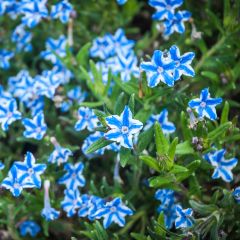
Lithodora diffusa Star
- Flowering time June, July
- Height at maturity 15 cm
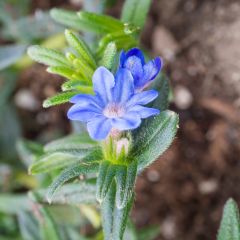
Lithodora diffusa Heavenly Blue
- Flowering time June, July
- Height at maturity 15 cm
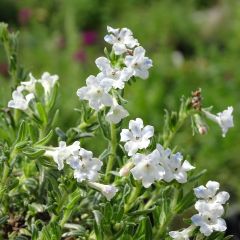
Lithodora diffusa Cambridge Blue
- Flowering time June, July
- Height at maturity 15 cm
Discover other Lithodora
View all →Available in 3 sizes
Available in 0 sizes
Available in 1 sizes
Available in 1 sizes
Available in 1 sizes
Available in 1 sizes
Planting
Where to plant?
Place lithodora in full sun: flowering will be more generous than in partial shade. It will tolerate partial shade but will develop less well. In sun, the young plant will be healthier and more vigorous, with faster growth and a more harmonious habit. It is preferable that it receives at least six hours of direct sun a day.
Lithodora needs a well-draining substrate, and appreciates stony or sandy soils… It does not like heavy, clay soils and is less tolerant of winter cold if the soil retains water. You can also plant on a mound or on sloping ground to improve water runoff. Lithodora is perfect in a rock garden or on an old stone wall, alongside other small plants that tolerate drought. As it spreads and requires little maintenance, it can be used to cover a slope. You can also plant it in a pot or container, placing it on a balcony or terrace. It can also be planted at the front of a perennial border, in full sun.
The Lithodora diffusa (notably variety ‘Heavenly Blue’) needs a slightly acidic substrate, while other species of Lithodora prefer soils with a calcareous tendency. It is also preferable that the substrate be humus-bearing, rich in humus.
As lithodora is a spreading plant, allow enough space around it to develop properly. Avoid installing it in a confined spot, cramped between other plants. Allow at least one metre between lithodora and other plants.
When to plant?
Plant lithodora in spring, around May. Autumn planting is still possible if you live in a region with a fairly mild climate. The most important thing is to avoid periods of frost.
How to plant?
- Dig a planting hole two to three times the size of the rootball. You can improve drainage by adding gravel or coarse sand. It can also be useful to plant on a mound or slope to aid water runoff.
- Remove lithodora from its pot, loosen the rootball slightly, then place it in the planting hole, with the top of the rootball level with the soil surface.
- Replace soil around it, then firm down with the flat of your hand.
- Water thoroughly.
Continue to water in the months following planting to give lithodora time to develop its root system, making it more resistant to drought.
Care
Lithodora copes quite well with drought, as its roots seek water deep in soil. However, if growing Lithodora diffusa, it’s best to water it during year of planting and during long dry periods, while avoiding excess moisture. Other species of lithodora (L. oleifolia, zahnii, rosmarinifolia, etc.) prefer soil to stay dry in summer.
We recommend lightly pruning lithodora once it has finished flowering (usually from late June). This helps keep habit compact and dense. Shorten shoots and take the opportunity to remove dead or damaged branches, as well as spent flowers.
You can also add some well-rotted compost in autumn to enrich soil. If ground is too poor, leaves of lithodora may yellow.
If growing it in a pot, consider repotting occasionally into a slightly larger pot.
Lithodora is not prone to disease; main problem you may encounter is excess moisture, which can cause roots to rot. As for parasitic insects, lithodora is sometimes attacked by aphids. These small insects settle on plant and suck sap, weakening it. To get rid of them, we recommend using black soap diluted in water, which you should spray onto plant.
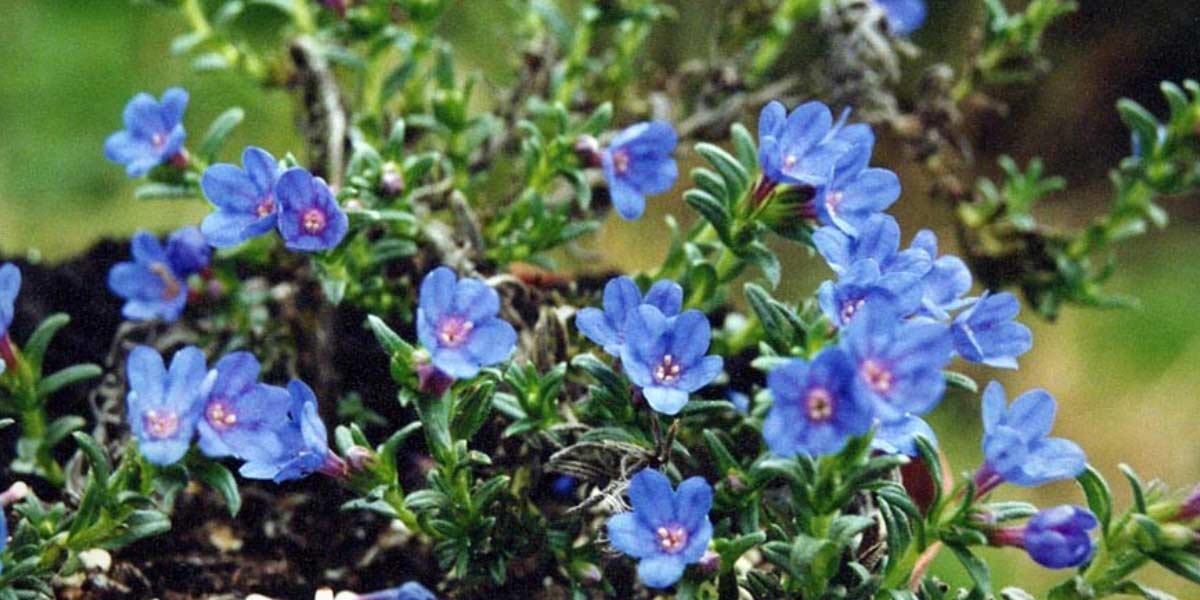
Lithodora diffusa ‘Heavenly Blue’ (photo Ghislain118)
Propagate Lithodora
Lithodora is easy to multiply by propagation by cuttings. Carry out in mid-summer.
- Prepare a pot with a mix of potting compost and coarse sand (for drainage). Water until it is thoroughly moist.
- Take a shoot, preferably healthy and well formed, without flowers, and cut it to about 5 cm in length.
- Insert base of shoot into substrate, then firm well around it to ensure good contact between soil and stem.
- Place pot in shelter, out of direct sunlight, and ensure substrate remains slightly moist.
- In first year, it is preferable to protect lithodora from cold in winter. Keep under cover and wait until spring to plant out.
Companion planting for lithodora
As it prefers full sun and well-drained, stony substrates, lithodora integrates very easily into a rockery. Plant with sedums, Phlox subulata or Phlox bifida, Alyssum montanum… Enjoy white flowering of Arenaria montana or Cerastium. You can also add some small gentians, such as Gentiana acaulis, prized for its trumpet-shaped flowers of truly intense blue. Consider including clumps of grasses for volume and movement. It is also possible to plant lithodora on a low wall, between stones… It will bring colour! It can be placed alongside sedums, houseleeks, Cerastium tomentosum and Cymbalaria muralis.
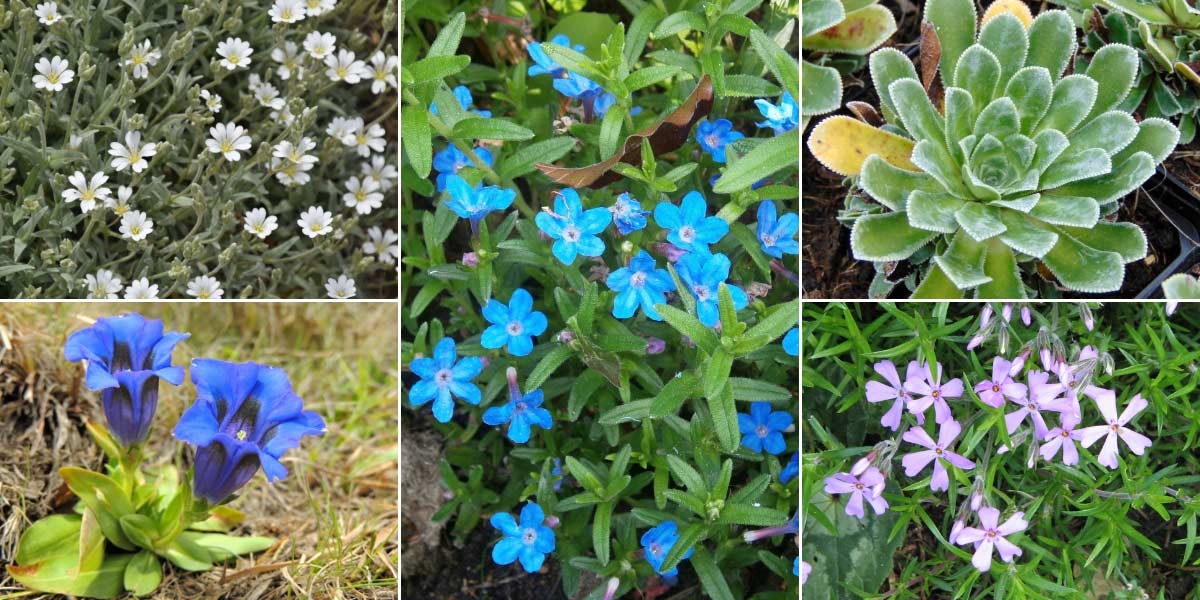
Lithodoras integrate easily into a rockery, with other plants suited to stony, dry soils. Cerastium tomentosum (photo Krzysztof Golik), Gentiana acaulis, Lithodora diffusa ‘Heavenly Blue’ (photo Meneerke bloem), Saxifraga cotyledon ‘Southside Seedling’, and Phlox subulata (photo Meneerke bloem)
You can also plant lithodora at front of a perennial border. Pair with taller plants that will add volume, such as large grasses and some bushes. We also recommend pairing it with other blue, mauve and white flowerings, to create a border with soft, delicate tones. Choose, for example, Anchusa azurea, Aquilegia vulgaris, centaureas… Also discover graceful light-blue inflorescences of Veronica gentianoides! Not forgetting Iris germanica and their elegant flowering (for example varieties ‘English Cottage’ or ‘Blue Crusader’).
However, you can also play with contrasts, knowing complementary colour to blue is orange. These tones reinforce each other and will energise the border. You can therefore pair lithodora with Euphorbia griffithii ’Dixter’, with Geum coccineum ‘Borisii’, with Iris germanica ‘Good Show’, or with Papaver orientale ‘Harvest Moon’…
You can also plant lithodora as a groundcover, for example at base of your bushes. Place in front of roses, Deutzia, mock orange, Weigelia… As lithodora effectively covers soil by forming a rather dense tapetum, it will limit development of weeds. Similarly, you can install it on a slope to vegetate a corner of the garden where you rarely tend.
Useful resources
- Discover our range of Lithodoras
- To combine lithodoras, discover our range of perennials for rockery
- Our article – How to create a beautiful perennial border?
- An article by Ingrid on our blog – Flower border: vary and mix shapes!
- To pair lithodoras with other flowers in matching tones, see Michael’s article – Spring blue flower palette
Frequently asked questions
-
Leaves on my Lithodora are turning yellow–pale green. What should I do?
Foliage can sometimes discolour when soil is too poor and plant is deficient in mineral nutrients. We therefore recommend applying a fertiliser for ericaceous plants and, if possible, adding well‑rotted compost annually.
-
Should I prune Lithodora?
It is not obligatory, but you can do a light pruning after flowering. This helps maintain a neat, dense and compact shape.
-
My lithodora is being attacked by aphids!
These small insects sometimes settle on lithodora and suck its sap, which weakens the plant. To eliminate them, use black soap diluted in water.
-
My lithodora's leaves have turned black.
If this happens in winter, it has probably suffered from the cold. It's not very serious. Lithodora is hardy and should regrow in spring, producing new leaves. Lithodora are somewhat more vulnerable during their early years. You can apply a layer of mulch around the clump to protect it.
-
Can I grow lithodora in a pot or planter?
Yes, lithodora can adapt to growing in a pot. However, it will need more regular watering than if planted in the ground.
- Subscribe!
- Contents
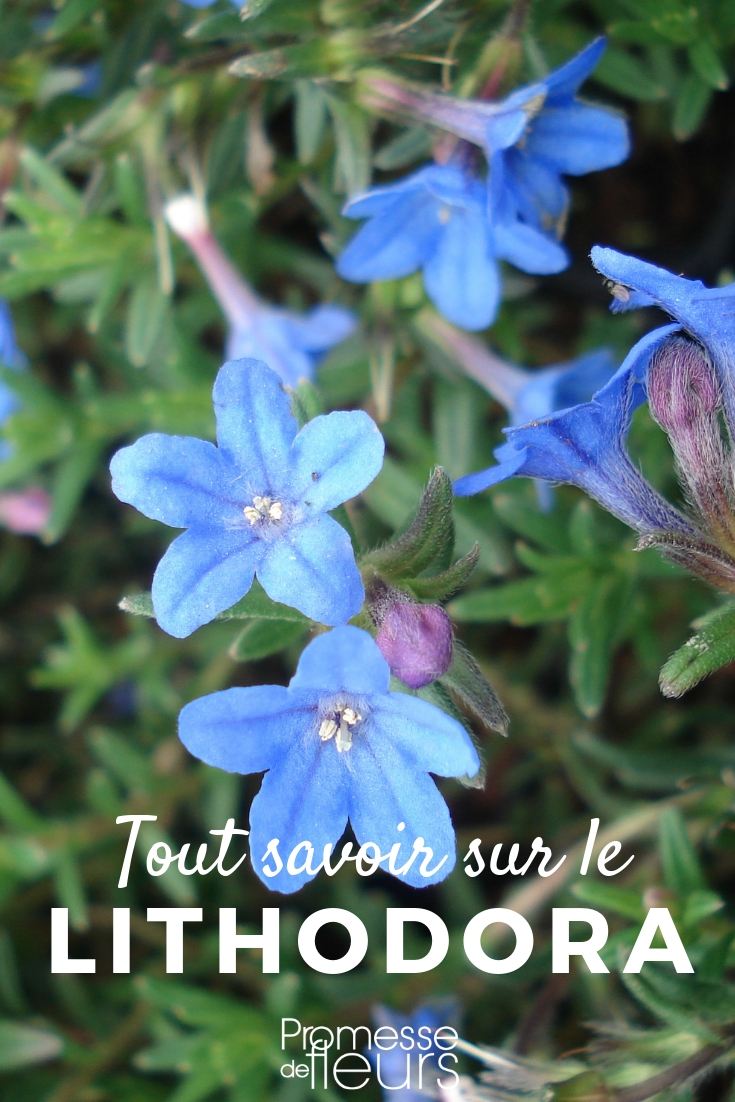
































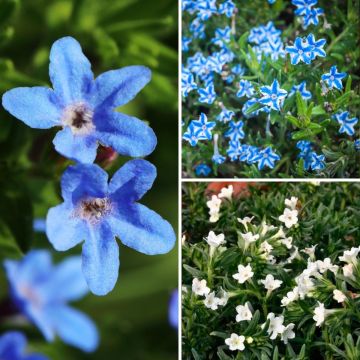


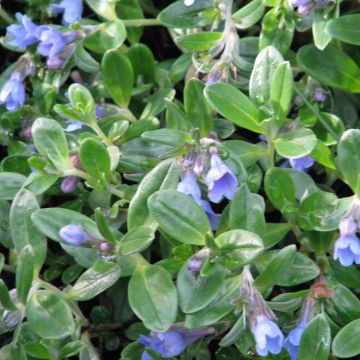

Comments